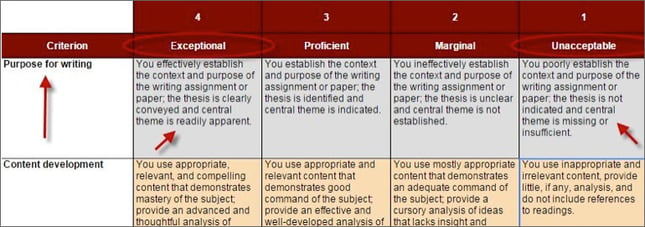
Written by Heather Russino
 By Heather Russino • November 24, 2023
By Heather Russino • November 24, 2023
You just began reviewing the syllabus for a new online course. It didn’t take you long to realize there are several graded written assignments along with a final paper scheduled in the course. You are motivated to work hard and submit quality work, but you are uncertain about one major thing—what exactly is the mentor looking for, especially in terms of a particular written assignment?
Is the mentor seeking an in-depth analysis? Should I be focusing heavily on a specific aspect of the assignment? Is there a research component? How many sources do I need for this project? How do I know exactly what I need to submit to achieve the best possible grade?
If you ever asked yourself any of the above questions, then you would benefit from referencing a rubric that may be linked to an assignment within a course. Students are more likely to meet expectations when they are given clear expectations for learning and performance. Here are a few key points about rubrics, how to use them effectively and help you earn a better score on that next graded assignment.
A rubric is an instructional, multipurpose scoring tool used to assess student learning; it is based on evaluative criteria and gradations of quality to communicate clear expectations to the student. It also serves as a helpful scoring strategy for mentors. In essence, a rubric clearly defines academic expectations and helps to ensure consistency in the evaluation and grading process.
A rubric is designed with criteria and descriptors to indicate the observable measurement of performance. For instance, take a look at the sample rubric below. Notice that one of the criteria is “purpose for writing.” The descriptor indicates exactly what a student must do in order to earn “4” points in this area. Examine each of the descriptors below the performance levels circled in red and review the differences between a point value of “4” and a point value of a “1.” Note the differences between exceptional and unacceptable work.

By identifying the criterion and differentiating between the various performance levels and corresponding descriptors, you’ll know precisely how to earn a better score on an assignment by ensuring your performance meets the criterion. Additionally, you’ll have a deeper understanding of how the mentor will grade the assignment.
Criteria are evaluated on a 4-3-2-1-0 basis. Total rubric points are converted first to a letter grade and then to a numerical equivalent based on a 0-100 scale.
Editor's Note: This article was originally published in 2015 and has been updated for accuracy.

Written by Heather Russino